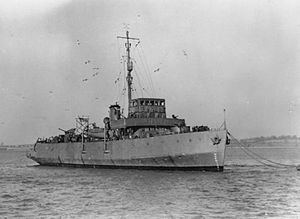Name HMS Plover Laid down 7 October 1931 Fate Sold for scrap, 1969 Construction started 7 October 1931 Draft 3 m | Ordered 21 July 1936 Commissioned 24 September 1937 Launched 8 June 1937 | |
 | ||
Builder | ||
HMS Plover was a coastal minelayer built for the Royal Navy in the mid-1930s. She laid over 15,000 mines during World War II and remained on active duty until she was sold for scrap in 1969.
Contents
Description
Plover displaced 805 long tons (818 t) at standard load and 1,020 long tons (1,040 t) at deep load. The ship had an overall length of 195 feet (59.4 m), a beam of 33 feet 9 inches (10.3 m) and a draught of 10 feet (3.0 m). She was powered by two vertical triple-expansion steam engines, driving two shafts, which developed a total of 1,400 indicated horsepower (1,000 kW) and gave a maximum speed of 14.75 knots (27.32 km/h; 16.97 mph). Steam for the engines was provided by two water-tube boilers. Plover carried a maximum of 116 long tons (118 t) of fuel oil. The ship's complement was 69 officers and men.
The ship initially mounted two 0.303 in (7.7 mm) machine guns, but after war broke out a single 12-pounder (3 in (76.2 mm)) gun was added aft as well as a 20-millimetre (0.8 in) Oerlikon autocannon forward. Plover was initially fitted with mine recovery gear, but her mine capacity increased from 80 to 100 after it was removed when World War II began. Sometime during the war she received a Type 286 air warning radar.
Career
HMS Plover was intended to conduct mining trials and was therefore fitted to recover as well as lay mines. During World War II she laid a total of 15,237 mines, including two that sank the German destroyer Z8 Bruno Heinemann off the Belgian coast in January 1942.
Near the end of the war the German submarine U-325 struck a mine which was part of a minefield laid by Plover on the morning of 30 April 1945 17 kilometres (11 mi) south of Lizard Point that consisted of 100 Mk XVII/XVII(8) mines.
The ship was kept in service after the war and took part in the Fleet Review to celebrate the Coronation of Queen Elizabeth II. She was sold to Thos W Ward in 1969. Plover arrived at their yard in Inverkeithing, Scotland in April 1969 to begin scrapping.
